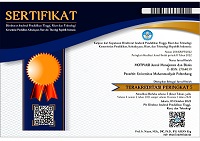PENERIMAAN E-MONEY: PENERAPAN UNIFIED THEORY OF ACCEPTANCE AND USE OF TECHNOLOGY (UTAUT) MODEL
Abstract
ABSTRACT
Purpose– This research aims to identify any variables that can influence e-money user behavior mediated by behavioral intentions using the UTAUT model
Design/methodology–. This research uses a quantitative-descriptive approach. Sampling used a purposive sampling method to achieve a sample size based on the Slovin formula. Data was collected by distributing a questionnaire in the form of a Google Form. The data analysis technique uses the Partial Least Squares-Structural Equation Model (PLSSEM) with the SmartPLS3 application.
Findings - The results of hypothesis testing show that performance expectations do not influence behavioral intentions. Effort expectancy, social influence, and facilitating conditions influence the intention to use e-money. Facilitating conditions influence user behavior. Behavioral intentions are able to mediate the influence of performance expectations, business expectations, and social influences, as well as facilitate conditions on e-money user behavior.
Keywords
Full Text:
PDFReferences
Ahdiat, A. (2023, May 7). Tren Belanja Pakai Uang Elektronik Tumbuh 1.000% dalam 5 Tahun Terakhir. Databoks. https://databoks.katadata.co.id/datapublish/2023/07/05/tren-belanja-pakai-uang-elektronik-tumbuh-1000-dalam-5-tahun-terakhir
Amrullah, A., & Priyono, A. (2018). Integrasi Aspek Risiko dalam Model Unified Theory Of Acceptance And Use Of Technology Untuk Menganalisis Penerimaan Teknologi Go-Ride. MIX: Jurnal Ilmiah Manajemen, VIII(1), 33–49. https://doi.org/dx.doi.org/10.22441/mix.2018.v8i1.003
Bashir, N. A. A. (2020). Penerapan Model UTAUT 2 Untuk Mengetahui Faktor-Faktor yang Memengaruhi Penggunaan SIORTU. ELINVO(Electronics, Informatics, and Vocational Education, 5(1), 42–51. https://doi.org/https://doi.org/10.21831/elinvo.v5i1.30636
Cao, Q., & Niu, X. (2019). Integrating context-awareness and UTAUT to explain Alipay user adoption. International Journal of Industrial Ergonomics, 69, 9–13. https://doi.org/https://doi.org/10.1016/j.ergon.2018.09.004
Chin, W. W., & Marcoulides, G. (1998). The Partial Least Squares Approach to Structural Equation Modeling. Advances in Hospitality and Leisure, 8(2). https://www.researchgate.net/publication/311766005_The_Partial_Least_Squares_Approach_to_Structural_Equation_Modeling
Damayanti, S. L., Yani, Y., Asnaini, A., & Afrianty, N. (2021). Minat Menggunakan E-Wallet pada Generasi Milenial dengan Pendekatan UTAUT (Unified Theory of Acceptance Use of Technology). Baabu Al Ilmi, 6(1). https://doi.org/http://dx.doi.org/10.29300/ba.v6i1.3988
Davis, F. D. (1989). Perceived Usefulness, Perceived Ease of Use, and User Acceptance of Information Technology. MIS Quarterly: Management Information Systems, 13(3), 319–340. https://www.jstor.org/stable/249008
Dwivedi, Y. K., Rana, N. P., Jeyaraj, A., Clement, M., & Williams, M. D. (2019). Re-examining the Unified Theory of Acceptance and Use of Technology (UTAUT): Towards a Revised Theoretical Model. Information Systems Frontier, 21, 719–734. https://doi.org/DOI 10.1007/s10796-017-9774-y
Febriani, D. Y. A. (2014). Pengaruh Manajemen Laba Terhadap Nilai Perusahaan Dengan Mekanisme Good Corporate Governance Sebagai Pemoderasi Pada Perusahaan Yang Tetdaftar do BEI. Jurnal Akuntansi Dan Keuangan UNILA, 19(1).
Febriaty, H. (2019). Pengaruh Sistem Pembayaran Non Tunai Dalam Era Digital Terhadap Tingkat Pertumbuhan Ekonomi Indonesia. Festival Riset Ilmiah Manajemen & Akuntansi. https://doi.org/https://doi.org/10.55916/frima.v0i2.47
Hartono, J., & Abdillah, W. (2014). Konsep dan Aplikasi PLS untuk Penelitian Empiris. BPFE.
Herudiansyah, G., Fitantina, F., & Suandini, M. (2023). Pengaruh Kualitas Pelayanan Reliability, Responsiveness Dan Assurance Terhadap Kepuasan Pasien Rumah Sakit Muhammadiyah. Motivasi: Jurnal Manajemen Dan Bisnis, 8(1), 9–17. https://doi.org/DOI: https://doi.org/10.32502/mti.v8i1
Indah, M., & Agustin, H. (2019). Penerapan Model UTAUT (Unified Theory of Acceptance and Use of Technology) Uuntuk Memahami Niat dan Perilaku Aktual Pengguna Go Pay Di Kota Padang. Jurnal Eksplorasi Akuntansi, 1(4), 1949–1967. https://doi.org/http://jea.ppj.unp.ac.id/index.php/jea/issue/view/16
Jati, N. J. (2012). Analisis Faktor-faktor Yang Mempengaruhi Minat Pemanfaatan dan Penggunaan Sistem E-Ticket (Studi Empiris pada Biro Perjalanan di Kota Semarang [Universitas Diponegoro]. https://ejournal3.undip.ac.id/index.php/accounting/article/view/562
Kotler, P., & Amstrong, G. (2017). Principle Marketing (17th ed.). Pearson Education.
Mujiatun, S., Julita, J., Effendi, I., Rahmayati, R., & Badawi, A. (2022). Sharia Financial Technology (Fintech) Management Model in Indonesia. Cuadernos de Economía, 45(128), 145–156. https://doi.org/https://doi.org/10.32826/cude.v1i128.716
Mustaqim, R. N., Kusyanti, A., & Aryadita, H. (2017). Analisis Faktor-Faktor yang Memengaruhi Niat Penggunaan E-Commerce XYZ Menggunakan Model UTAUT (Unified Theory Acceptance and Use Of Technology). Jurnal Pengembangan Teknologi Informasi Dan Ilmu Komputer, 2(7). https://j-ptiik.ub.ac.id/index.php/j-ptiik/article/view/1653
Normah, N., Hadi, A., & Cahya, F. N. (2023). The Acceptance of ATM Drive Thru of Bank CIMB Bintaro Branch Jakarta Using UTAUT Model. Jurnal Paradigma, 25(2), 135–142. https://doi.org/https://doi.org/10.31294/p.v25i2.1857
Nugroho, A. P., Zulni, D. A., & Andriansyah, Y. (2023). Exploring The Adoption Of Digital Wallets Among Islamic Millenials In Yogyakarta, Indonesia Using An Extended UTAUT Model : The Role Of Islamic Consumption Ethics. Journal of Theoretical and Applied Information Technology, 101(14), 5528–5540. https://www.jatit.org/volumes/hundredone14.php
Nuryanti, I., Firmansyah, A., & Fadly, A. (2006). Kajian O[perasional E-Money. Bank Indonesia.
Pah, V. C., & Kornelius, K. (2023). Pengaruh Behavioral Intention dan Penerapan Model UTAUT terhadap User Acceptance Digital payment in Quick Response Indonesian Standard (QRIS). Journal of Economics and Business UBS, 12(1). https://doi.org/https://doi.org/10.52644/joeb.v12i1.145
Popovska-Kamnar, N. (2014). The Use of Electronic Money and Its Impact on Monetary Policy. Journal of Contemporary Economic and Business Issues, 1(2), 79–92. https://www.econstor.eu/bitstream/10419/147460/1/86795244X.pdf
Putri, N. K. R. D., & Suardikha, I. M. S. (2020). Penerapan Model UTAUT 2 Untuk Menjelaskan Niat Dan Perilaku Penggunaan E-Money di Kota Denpasar. E-Jurnal Akuntansi, 30(2), 540–555. https://doi.org/https://doi.org/10.24843/EJA.2020.v30.i02.p20
Rahmatika, U., & Fajar, M. A. (2019). Faktor - Faktor Yang Mempengaruhi Minat Penggunaan Electronic Money: Integrasi Model Tam – Tpb Dengan Perceived Risk. Nominal: Barometer Riset Akuntansi Dan Manajemen, 8(2), 274–284. https://doi.org/10.21831/nominal.v8i2.26557
Rizally, D., Sakti, D. P. B., & Muhsaf, S. A. (2023). Pengaruh UTAUT Terhadap Behavioral Intention yang di Mediasi oleh Use Behaviour SIMRS RSUD Kota Mataram. Empiricsm Journal, 4(1). https://doi.org/https://doi.org/10.36312/ej.v4i1.1332
Sugiyono. (2018). Metode Penelitian Kuantitatif, Kualitatif dan R&D. Alfabeta Bandung.
Sutanto, S., Ghozali, I., & Handayani, R. S. (2018). Faktor-Faktor Yang Memengaruhi Penerimaan dan Penggunaan Sistem Informasi Pengelolaan Keuangan Daerah (SIKD) Dalam Perspektif The Unified Theory of Acceptance and Use of Technology 2 (UTAUT 2) Di Kabupaten Semarang. Jurnal Akuntansi Dan Auditing, 15(1). https://doi.org/https://doi.org/10.14710/jaa.15.1.37-68
Venkatesh, V., Morris, M. G., Davis, G. B., & Davis, F. D. (2003). User Acceptance of Information Technology: Toward a Unified View. MIS Quarterly, 27(3), 425–478. https://doi.org/10.2307/30036540
Venkatesh, V., Thong, J. Y. L., & Xu, X. (2012). Consumer Acceptance and Use of Information Technology: Extending the Unified Theory of Acceptance and Use of Technology. MIS Quarterly, 36(1), 157–178. https://doi.org/https://doi.org/10.2307/41410412
Vlasov, A. V. (2017). The Evolution of E-money. European Research Studies Journal, 20(1), 215–224. https://www.um.edu.mt/library/oar//handle/123456789/28785
DOI: https://doi.org/10.32502/mti.v9i1.7989
Refbacks
- There are currently no refbacks.
Copyright (c) 2024 MOTIVASI
Motivasi: Jurnal Manajemen dan Bisnis is Published by Management Department, Economic and Business Faculty, Muhammadiyah University of Palembang. This work is licensed under a Creative Commons Attribution-ShareAlike 4.0 International License.
Indexed/Abstracted






.png)
.png)



